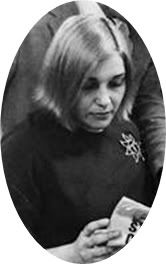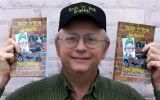
Lillian Roxon
By STEVE SEYMOUR
Back in the day, one of my favorite books was the encyclopedia. Not Britannica or World Book, mind you, but "Lillian Roxon's Rock Encyclopedia."
Roxon's scholarly work was found in the reference section at the local library and it drew me back to the shelves time and time again.
The author had assembled the first text taking a comprehensive look at the intriguing new rock 'n' roll music scene.
The book contained informative biographies, discographies, commentary and analysis of over 1,200 rock stars.
You could discover the diverse world of rock music by flipping through the book's 611 pages.
The dust jacket promised coverage of everyone from Roosevelt Gook (piano player for Tom Rush) to the Beatles.
Roxon crammed her book with facts. Want to know who was in Ultimate Spinach, or the tracks on Blue Cheer's first album, or what feedback is? Roxon had the answers.
Born in Italy, but raised in England and Australia, Roxon came to New York in 1959.
She planned to write about this country for Australian newspapers and a world-wide feature syndicate, but became fascinated by pop music during the mid-1960s.
Her articles were among the first to treat the emerging rock scene seriously.
In 1968, she was commissioned to write a comprehensive treatment of rock music, published by Grosset & Dunlap of New York.
"Trying to get the rock world to keep still long enough for me to take its picture was one of the most difficult tasks in putting this book together. Groups split even as I wrote of their inner harmony, and got themselves together just as I had acknowledged their tragic demise," Roxon wrote of the book.
"I wanted to record the facts without losing the feelings. In the end, though, the music itself has to tell the story. This book is the companion to that story," she added.
Unfortunately, Roxon died after suffering a severe asthma attack at age 41. Despite her death in 1973, Roxon's influence lives on through her writings.
So respected was Roxon that some admirers refer to her as "the mother of rock."
While Roxon poured countless hours into her book, so did music researcher Joel Whitburn.
He began collecting 45 rpm singles as a teen in the 1950s. As his hobby grew, he began to organize the records with data he obtained from charts published by Billboard.
Consequently, Whitburn compiled that information into a vital volume called "Top Pop Records, 1955-1970."
The book listed every rock record charted by the magazine from Nov. 2, 1955 to Dec. 27, 1969. Even at that time, the book included 9,800 recordings by 2,500 recording artists.
Compiling that information must have been a monumental task in the days before computers.
Whitburn also included the date each record first charted, its highest position and total weeks on the chart. He also included the record title, label and catalog number.
Not long after it came out, I felt compelled to purchase Whitburn's hardcover edition which comprised his original research and supplement for 1970.
I still remember buying the book at Canterbury Book Store because it was a bit on the pricey side. Still, considering how often I've consulted it, the publication was a tremendous bargain.
The book was very handy when I was trying to collect all of an artist's 45s or determining if a greatest hits album actually contained all of an artist's hits.
I used the book to study the singles of the Beatles, Rolling Stones, the Who, Animals, and all my favorite acts.
My early version of the book was published by Gale Research Co., located in Detroit's Book Tower.
Over the years, Whitburn's work has proved popular among pop music fans and he has issued updated books on a regular basis.
A native of Wisconsin, Whitburn is widely recognized as the leading historian on the music charts and his collection includes every charted Hot 100 and pop single beginning in 1920.
A few weeks ago, I decided it was finally time to add Roxon's book to my library. I bought a copy by way of the Internet from Market Street Bookstore in Maysville, Kentucky.
Looking through it now is just as fascinating and informative as it was when it was newly published.
Mary Travers
After singer and songwriter Mary Travers died on Sept. 16, I looked up the entry for Peter, Paul and Mary in Roxon's book.
I learned that the folk three-some was the idea of manager Albert Grossman, who sought to improve on the Kingston Trio with a group including two men and a woman.
Peter, Paul and Mary were a huge success, opening the door to a folk rock scene which included Bob Dylan, perhaps the greatest rock poet of his generation.
A peak into Whitburn's book, meanwhile, shows the trio's first hit was "Lemon Tree" in 1962. Their Top Ten entries included "If I Had a Hammer," "Puff The Magic Dragon" and "I Dig Rock And Roll Music."
They made hits of Dylan's "Blowin' In The Wind" and "Don't Think Twice, It's Alright," years before the folk singer from Minnesota hit the charts with his own recordings.
Whitburn's book lists the last Peter, Paul and Mary hit as "Leavin' On A Jet Plane," written by John Denver, which went to No. 1 in late 1969.
Peter, Paul and Mary disbanded two years later, but had several reunions.
Roxon described the group's power: "They did have a hammer, they had a bell, they had a song to sing, and they sang it when it counted."
The Whitburn and Roxon books provided me with a foundation to understand and appreciate the rock 'n' roll music which has held my attention for over four decades.
While listening to music is better than reading about it, knowing some pertinent facts can enhance the experience, don't you agree?


 I've enjoyed rock music and writing since I was a teenager in the 60s. I feel lucky to have been around when rock's greatest stars created their most enduring hits. At the same time I found I enjoyed writing, as well. I worked on my high school newspaper and magazine, was editor of several college publications and earned a bachelor's degree from Central Michigan University in 1973. I worked for the daily newspaper in my hometown after graduating, becoming managing editor after a few years. By the 1980s, I moved into public relations. In 1985, my wife Sue and I opened a retail music store, The Record Rack, which we still own. Rock 'n' roll has been integral to me and for the last 2O years I've been earning my living from it even though I don't have a musical bone in my body. In recent years, I've also I edited a small local magazine and launched a micro FM radio station. Now, I'm finally combining my love of writing and rock 'n' roll. I can't sing a note, but I know what I like. I'll tell you all about it when you read on. I hope you have as much enjoyment reading these installments as I've had writing them.
I've enjoyed rock music and writing since I was a teenager in the 60s. I feel lucky to have been around when rock's greatest stars created their most enduring hits. At the same time I found I enjoyed writing, as well. I worked on my high school newspaper and magazine, was editor of several college publications and earned a bachelor's degree from Central Michigan University in 1973. I worked for the daily newspaper in my hometown after graduating, becoming managing editor after a few years. By the 1980s, I moved into public relations. In 1985, my wife Sue and I opened a retail music store, The Record Rack, which we still own. Rock 'n' roll has been integral to me and for the last 2O years I've been earning my living from it even though I don't have a musical bone in my body. In recent years, I've also I edited a small local magazine and launched a micro FM radio station. Now, I'm finally combining my love of writing and rock 'n' roll. I can't sing a note, but I know what I like. I'll tell you all about it when you read on. I hope you have as much enjoyment reading these installments as I've had writing them.


No comments:
Post a Comment